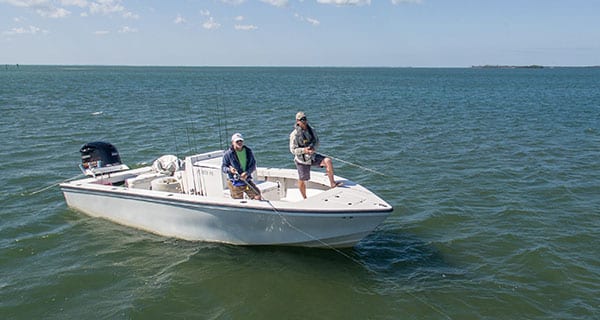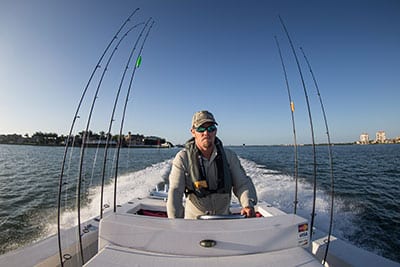
By Tom Schlichter
2018 was a good year for recreational boat sales. So was 2017 and 2016. In fact, boat sales across the country have been on a steady incline for the past seven years and industry experts expect that trend to continue through the year ahead. That, in the long run, is good not only for boat manufacturers, boat dealers, marinas and other industry stake-holders, but for anglers, too.
When you drill down into the economic impact of recreational angling across the country, you can find some pretty impressive statistics. According to the American Sportfishing Association (https://asafishing.org), over 49 million Americans go fishing each year. That’s more than go bowling, play basketball or soccer, making it the second most popular outdoors activity after jogging. It’s triple the number of active downhill skiers and snowboarders combined, and twice as many people than attended every NFL game last year. Collectively, anglers spend nearly $50 billion dollars each year on fishing-related gear and travel.
“That’s big bucks,” says, Thom Dammrich, president of the National Marine Manufacturers Association (NMMA), which represents the nation’s recreational boat, engine and marine accessory manufacturers, “and we can see these numbers reflected in the retail unit sales of new powerboats. Last year, sales were up an estimated 4 percent over the previous year with approximately 280,000 units sold. That’s the highest total since 2007, and the outlook for 2019 remains positive with continued growth expected to bring a 3 to 4 percent increase in new powerboat retail sales.”

NMMA estimates that the recreational boating industry contributes a total of $170.3 billion in economic activity to the U.S. economy, an increase of approximately $49 billion since the last time the association reported on boating’s economic impact in 2012.
“A big part of that comes from anglers,” continues Dammrich. “Seventy-percent of boaters fish, and half of all fishing is done from boats. Saltwater recreational boat sales, specifically, have seen double-digit growth for four or five years now, so that’s a very hot market. The biggest driver is always innovative new products. The manufacturers keep adding new products that simply aren’t available in the pre-owned or after market. That means anglers who want the latest and greatest technology have to get a new boat, which really helps drive new sales.”
It also makes pre-owned boats available to other anglers who want to get out on the water but maybe can’t afford the price of a brand new vessel. So, in the long run, anglers buying new boats probably also helps bring additional families into the angling fraternity.
Yet another angling-related aspect that helps drive the boating market in a positive direction is when fishing seasons are extended or limits are eased. Down south, for example, the red snapper season was extended in 2018 from 2 days to 45 days. That, noted Dammrich, spurred additional boat sales along the Gulf Coast and Florida. Continued pressure for expanded seasons (within reasonable parameters) for recreational fishing, he believes, is good for both anglers and boat sales in the long run.
“When we meet with politicians,” says Thom, “we tell them that if they get us longer seasons or relax catch restrictions when and where appropriate considering the health of fish stocks, the boating industry will build new factories and hire more people. We’ll make a bigger contribution the economy.”
There’s still a long way to go on that front, but the recent passage of the Modern Fish Act was the first time Congress ever passed a piece of legislation devoted solely to saltwater recreational fishing. That’s a major milestone, and it shows a growing awareness among politicians of the economic impact of outdoors recreational spending – of which fishing and boating are the largest segments.
That increasing awareness is largely due to the efforts of the Outdoor Recreation Roundtable, notes Dammrich. “It’s an organization made up of representatives from the boating, fishing, RV, archery, snowmobile and other outdoor players. Congress is beginning to recognize outdoor recreation is an important part of our economy. The Bureau of Economic Analysis (BEA) last year reported outdoor recreation represents 2.2% of the nation’s GDP. By comparison, agriculture across the country represents 1% of GDP. So boating and fishing clearly have an important economic impact and much of that is based on anglers having access to the fisheries.”
To that end, if more people buy boats and become invested in the boating and fishing lifestyle, our outdoors communities should have more clout when it comes to managing our waters, fisheries, resources, etc. But it still takes standing up for ourselves.
“In the long run, the only way to improve fisheries management and boating access is for congress to hear from its boating and fishing constituents,” says Dammrich. “Even NOAA’s own data tells us recreational fishing contributes more to the US economy than commercial fishing, for example, and yet NOAA remains commercial fishing centric. We would all like to see recreation given its due but to get there is going to require recreational anglers to talk with their congressional representatives. We’ve got a little momentum now, so there’s no better time to be getting engaged.”









